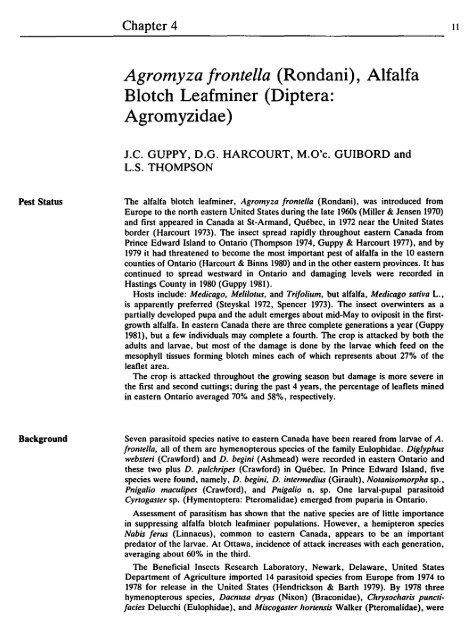pdf, 57.71Mb - Entomological Society of Canada
pdf, 57.71Mb - Entomological Society of Canada
pdf, 57.71Mb - Entomological Society of Canada
Create successful ePaper yourself
Turn your PDF publications into a flip-book with our unique Google optimized e-Paper software.
Pest Status<br />
Background<br />
Chapter 4<br />
Agromyza frontella (Rondani), Alfalfa<br />
Blotch Leafminer (Diptera:<br />
Agromyzidae)<br />
J.C. GUPPY, D.G. HARCOURT, M.O'c. GUIBORD and<br />
L.S. THOMPSON<br />
The alfalfa blotch leafminer, Agromyza frontella (Rondani), was introduced from<br />
Europe to the north eastern United States during the late 1960s (Miller & Jensen 1970)<br />
and first appeared in <strong>Canada</strong> at St-Armand, Quebec, in 1972 near the United States<br />
border (Harcourt 1973). The insect spread rapidly throughout eastern <strong>Canada</strong> from<br />
Prince Edward Island to Ontario (Thompson 1974, Guppy & Harcourt 1977), and by<br />
1979 it had threatened to become the most important pest <strong>of</strong> alfalfa in the 10 eastern<br />
counties <strong>of</strong> Ontario (Harcourt & Binns 1980) and in the other eastern provinces. It has<br />
continued to spread westward in Ontario and damaging levels were recorded in<br />
Hastings County in 1980 (Guppy 1981).<br />
Hosts include: Medicago, Melilollls, and Trifolium, but alfalfa, Medicago sativa L.,<br />
is apparently preferred (Steyskal 1972, Spencer 1973). The insect overwinters as a<br />
partially developed pupa and the adult emerges about mid-May to oviposit in the firstgrowth<br />
alfalfa. In eastern <strong>Canada</strong> there are three complete generations a year (Guppy<br />
1981), but a few individuals may complete a fourth. The crop is attacked by both the<br />
adults and larvae, but most <strong>of</strong> the damage is done by the larvae which feed on the<br />
mesophyll tissues forming blotch mines each <strong>of</strong> which represents about 27% <strong>of</strong> the<br />
leaflet area.<br />
The crop is attacked throughout the growing season but damage is more severe in<br />
the first and second cuttings; during the past 4 years, the percentage <strong>of</strong> leaflets mined<br />
in eastern Ontario averaged 70% and 58%, respectively.<br />
Seven parasitoid species native.to eastern <strong>Canada</strong> have been reared from larvae <strong>of</strong> A.<br />
frontella, all <strong>of</strong> them are hymenopterous species <strong>of</strong> the family Eulophidae. Diglyphus<br />
websteri (Crawford) and D. begini (Ashmead) were recorded in eastern Ontario and<br />
these two plus D. pulchripes (Crawford) in Quebec. In Prince Edward Island, five<br />
species were found, namely, D. begini, D. intermedius (Girault), Notanisomorpha sp.,<br />
Pnigalio maculipes (Crawford), and Pnigalio n. sp. One larval-pupal parasitoid<br />
Cyrtogaster sp. (Hymentoptera: Pteromalidae) emerged from puparia in Ontario.<br />
Assessment <strong>of</strong> parasitism has shown that the native species are <strong>of</strong> little importance<br />
in suppressing alfalfa blotch leafminer populations. However, a hemipteron species<br />
Nabis ferus (Linnaeus), common to eastern <strong>Canada</strong>, appears to be an important<br />
predator <strong>of</strong> the larvae. At Ottawa, incidence <strong>of</strong> attack increases with each generation,<br />
averaging about 60% in the third.<br />
The Beneficial Insects Research Laboratory, Newark, Delaware, United States<br />
Department <strong>of</strong> Agriculture imported 14 parasitoid species from Europe from 1974 to<br />
1978 for release in the United States (Hendrickson & Barth 1979). By 1978 three<br />
hymenopterous species, Dacnusa dryas (Nixon) (Braconidae), Chrysocharis punctifacies<br />
Delucchi (Eulophidae), and Miscogaster hortensis Walker (Pteromalidae), were<br />
11
















